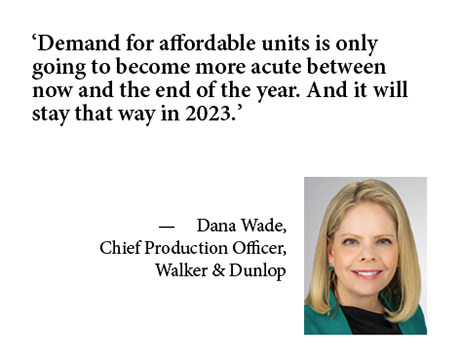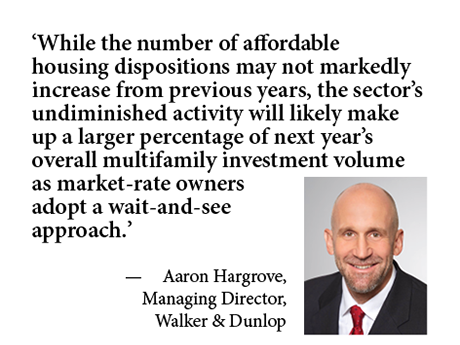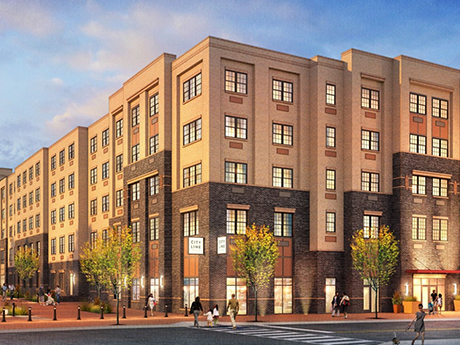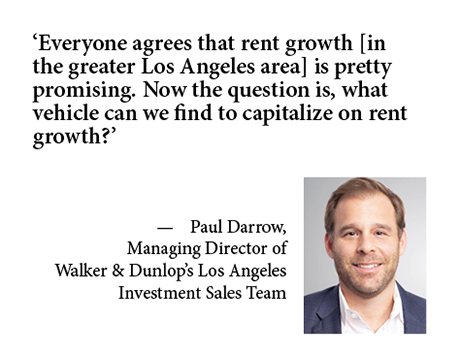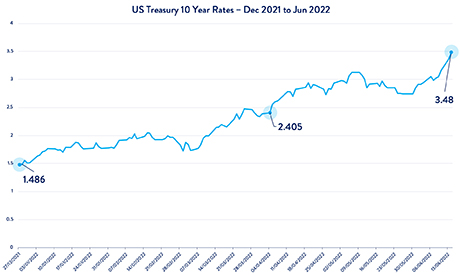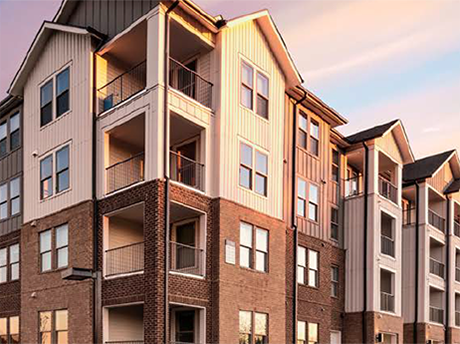Forty-year-high inflation rates that are outpacing wage growth and eating away at personal income are exacerbating already outsized resident demand for affordable housing financed by the federal Low-Income Housing Tax Credit (LIHTC) program. But it seems that obstacles to supplying new units to meet that demand are only multiplying. Those range from a shortage of housing tax credits needed to fund new supply to resistance to multifamily development at the local level. Meanwhile, higher mortgage rates are making home buying more difficult and expensive. In turn, that is creating more apartment renters, thereby putting upward pressure on rental rates. In September, for example, the average monthly rent price nationwide hit $1,759, an increase of 7.8 percent from the prior year, according to Realtor.com’s monthly rental report. That’s also nearly 25 percent higher than September 2019, the organization reports. What’s more, from 2015 through 2020 — long before mortgage rates spiked — the U.S. lost 4.7 million apartment units with rents less than $1,000 per month, according to U.S. Apartment Demand Through 2035, a report by the National Multifamily Housing Council and National Apartment Association. “Demand for affordable units is only going to become more acute between now and the end of …
Walker & Dunlop
Affordable HousingContent PartnerDevelopmentFeaturesLoansMidwestNortheastSoutheastTexasWalker & DunlopWestern
Affordable HousingContent PartnerFeaturesLeasing ActivityLoansMidwestMultifamilyNortheastSoutheastTexasWalker & DunlopWestern
Walker & Dunlop: Affordable Housing’s Appeal Grows for Investors
With transaction volume for market-rate housing beginning to ebb, affordable housing investment is poised to play a more central role in the months ahead. Several factors have broadened the allure of affordable housing as an investment vehicle in recent years. When the pandemic began taking a toll on market-rate housing performance, investors saw federal, state and even local governments enact measures to help residents at affordable communities maintain their rent payments and help ensure housing remained available for people struggling financially. We saw the interest level in Section 8 properties, for example, increase significantly during the pandemic, due chiefly to federal guarantees backing those rent streams. From a financing perspective, the strong commitment shown by Fannie Mae, Freddie Mac and the Federal Housing Administration to preserve liquidity for affordable housing has bolstered development and investment in the space. Due to the required hold periods, affordable housing investments are less affected by market cycles, so liquidity should remain strong. Now, changing economic forces promise to drive new equity to the affordable sphere and fuel further investment. The Federal Open Market Committee’s resolve to combat record inflation is exerting upward pressure on mortgage rates and, eventually, cap rates, which could discourage sellers …
AcquisitionsContent PartnerDevelopmentFeaturesLoansMidwestMultifamilyNortheastSoutheastTexasWalker & DunlopWestern
Walker & Dunlop: Small Balance Lending Presents New Financing Option for Turbulent Market
Following a similar move in June and July, the Fed implemented its third consecutive interest rate hike of 75 basis points in mid-September. This is the biggest three-month interest rate swing since 1994. What does this all mean for investors in the small balance lending (SBL) segment of the multifamily sector? The combination of rising interest rates, inflation and market uncertainty tempts borrowers to sit on the sidelines until conditions improve. Turbulent markets also limit financing options, as many lenders and capital sources tend to become cautious and pull back. But the need for capital transcends market cycles and seasoned multifamily investors know that rate hikes are nothing new. We’ve been here before with interest rates of nearly 7 percent in the 2000s and a record high of nearly 20 percent in the 1980s. The business of real estate investing never stops. New acquisition opportunities arise as distressed owners are forced to sell, cap rates settle to more conservative levels and the market shifts in the buyer’s favor. All things considered, now is the time to seek new investment opportunities. In fact, Warren Buffett once offered the timeless advice that it is wise for investors to be “fearful when others …
JERSEY CITY, N.J. — Walker & Dunlop has arranged an $85.4 million bridge loan for the refinancing of City Line East and City Line West, two adjacent apartment complexes totaling 342 units in Jersey City. Both properties are located within the University Place mixed-use development and feature studio, one- and two-bedroom units and Class A amenities. John Banas, Kris Wood, Christopher Philipps, John Wilson, Rhett Saltiel and Erik DiGirolamo of Walker & Dunlop arranged the two-year, fixed-rate loan through an undisclosed debt fund on behalf of the New Jersey-based borrower.
AcquisitionsCaliforniaContent PartnerDevelopmentFeaturesLeasing ActivityMultifamilyWalker & DunlopWestern
LA Multifamily Investment Deals See Volume Normalization, Pricing Resets for Select Assets
Multifamily investment transaction volume had an unprecedented year in 2021, and the first six months of 2022 were quite robust. Now, economic uncertainty in the form of rising interest rates and a cooling economy has created some hesitancy on the part of investors. “Some normalization is occurring in the market now, in addition to a pullback because of what is going on in the capital markets and economy,” says Paul Darrow, a managing director of Walker & Dunlop’s investment sales team based out of Los Angeles. Walker & Dunlop is one of the largest providers of capital to commercial real estate industry in the United States. Darrow sat down with REBusinessOnline to talk about multifamily investment sales trends in the Los Angeles area and the opportunities he sees for investors down the road. REBusiness: Investor interests have shifted in the past few months. What kinds of properties are investors most interested in now? Darrow: It’s a mixed bag when it comes to investor appetite. Those who raised money to buy specific types of buildings are obviously guided by what they’ve promised their investors in the form of return profiles and risk. Core funds, for example, can’t just switch to value-add or …
ILLINOIS — Walker & Dunlop Inc. has structured $57.6 million in HUD-insured loans for the refinancing of three skilled nursing facilities in Illinois. Joshua Rosen of Walker & Dunlop led the origination team. The first transaction consisted of a $15.6 million loan for Avantara Park Ridge, a 154-bed community in Park Ridge. Walker & Dunlop also arranged a $28.7 million loan for Moraine Court Supportive Living, a 185-bed community in Bridgeview, and a $13.3 million loan for Aperion Care Elgin, a 101-bed property in Elgin. The borrower was undisclosed.
Content PartnerFeaturesLeasing ActivityLoansMidwestMultifamilyNortheastSoutheastTexasWalker & DunlopWestern
How to Maintain Multifamily Investment Momentum in the Face of Rising Interest Rates
By Melissa Jahnke, associate director of operations, Walker & Dunlop The Federal Reserve raised interest rates by 75 basis points in June and then another 75 basis points in July, sending shockwaves across the commercial real estate industry. Fortunately, there are opportunities and solutions to bypass these potential roadblocks. Specifically, investors in a segment of multifamily housing known as small balance lending (SBL), encompassing five- to 150-unit properties, have several options to realize their aspirations for financing multifamily portfolios. View a higher resolution version of the timeline above here. During a recent webcast “Financing Amid Rising Rates: Best Approaches for $1M-$15M Multifamily Loans,” Walker & Dunlop’s market experts spoke about navigating today’s financing landscape. The expert panel included Allison Williams, senior vice president and chief production officer; Allison Herrera, senior director of SBL; and Tim Cotter, director of capital markets. These experienced professionals have found ways to make deals happen in a wide variety of financing environments and have shared their perspectives and guidance. If you are an owner of five- to 150-unit properties that require loans between $1 million to $15 million, the following will help you navigate today’s financial environment and build your momentum. Step 1: Consider the …
NEW YORK CITY — Walker & Dunlop Inc. has arranged $754 million in financing for Aman New York, a luxury hotel and condo development in Midtown Manhattan. Aman New York occupies the top 20 floors of the 100-year-old Crown Building at the corner of 57th Street and Fifth Avenue, across the street from Trump Tower. OKO Group was the developer. The 95,000-square-foot residential portion includes 22 units, while the 117,000-square-foot hotel section contains 83 guest rooms and suites. The rooms are among New York’s largest, and the hotel is the only one in New York to offer working fireplaces in each room. The lower floors of the building remain retail space. The hotel portion is scheduled to open on Tuesday, Aug. 2. Reservations will be available beginning Monday, July 25. The development is Aman’s first U.S. urban residence project and provides special features for owners such as private entrances, plus access to three dining venues, a jazz club, wine room and 25,000-square-foot Aman Spa. Nearly all of the condos are pre-sold, with one of the units selling for $55 million, marking one of the priciest residential transactions in New York so far this year. Originally built in 1921, the Crown …
Last year, a city known more for music than multifamily development led the nation in new construction growth rates, with luxury high rises popping up from downtown to the Gulch to along the Cumberland River. Nashville, attracting an abundance of debt and equity funding from sources old and new, is now considered an institutional-grade market. The driving force behind this growth: technology. Today, singers, songwriters and studio artists share the city with a growing number of software developers, systems architects and startup founders — and all of these innovators need a place to live, work, shop and play. Nashville’s tech evolution started from a solid foundation in healthcare, automotive and education, including HCA Healthcare and its associated startups, spinoffs and subsidiaries and an automotive hub that includes North American headquarters for Nissan and Korean tire manufacturer Hankook, as well as EV and battery cell manufacturing plants for GM. Twenty nine institutions of higher education, including Vanderbilt University, further helped develop a strong pipeline of tech talent. This ecosystem and a business-friendly climate have attracted some of the nation’s top tech employers: Amazon, who chose the metropolitan area for its much-coveted Center of Excellence; Oracle, relocating from Austin; and Capgemini, whose …
Content PartnerFeaturesLeasing ActivityMidwestMultifamilyNortheastSoutheastTexasWalker & DunlopWestern
Walker & Dunlop: Spring Multifamily Market Contends with Inflation, Housing Bubble Fears
By Walker & Dunlop’s Research Department Inflation and a New Era of Monetary Tightening Amid 40-year high inflation rates, home prices that have surged by over 40 percent in the past three years and double-digit price increases in basic necessities such as food, gas and electricity, the United States seems to be beset on all sides. Inflation has become the question of the day with little relief even after monetary tightening began earlier in the year. After a quarter point increase in the Federal Reserve target rate in March, the Fed implemented a whopping 50 basis point increase in the target Federal Funds rate in May after April inflation remained at 8.2 percent, near the March high of 8.6 percent.[1] The central bank’s goal is to reduce inflation to an annual rate of approximately 2 percent. The employment base, the Fed’s other prime objective, seems to remain strong. Unemployment (at 3.6 percent in April) remains low and employment growth of 390,000 in May beat economist expectations. The Fed’s job now is to beat inflation and prevent it from becoming embedded in consumer expectations. Why? Because once inflation becomes embedded in expectations, it changes consumer behavior and becomes somewhat of a …


